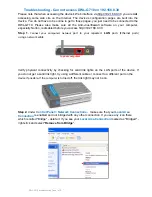
pulsAR
radio Operator's Manual
6.2.2
Earth curvature
With long links the earth curvature can prevent the two antennas from seeing each other. This is
illustrated in tables 6.2 and 6.3, which show the minimum antenna heights required, at both ends of
the link, to simply clear the earth surface at various distances. As the distance grows the effect
worsens requiring you to have access to high elevation points to deploy such links. The values in the
table used a typical atmospheric refraction factor of 4/3 (see below).
6.2.3
Fresnel Zone
The Fresnel zone is a long ellipsoid that stretches between the two antennas. The
first
Fresnel zone is
such that the difference between the direct path (AB) and an indirect path that touches a single point
on the border of the Fresnel zone (ACB) is half the wavelength (see figure 6.3).
Figure 6.3– Fresnel Zone Definition
If a significant portion of the Fresnel Zone is obstructed the receive-signal-strength at the receiving
antenna can be significantly attenuated. A rule of thumb is that you need at least 60% of the first
Fresnel Zone clear of any obstructions in order for the radio wave propagation to behave as if it is in
“free space”.
Even though at 2.4 GHz half of the wavelength is only 2.4 inches (6.2 cm), at long distances the
radius of this ellipsoid can be quite large. This is illustrated in tables 6.2 and 6.3, which show the
radius of this (60%) ellipsoid at the mid-point for various distances.
Table 6.2 – Antenna heights (meters) to clear the earth and 60% of the Fresnel Zone (2.4 GHz)
Distance (km):
5
10
20
30
40
50
60
70
Antenna height to clear
earth (meters):
0.4
1.5
6
13
24
37
53
72
60% Fresnel Zone radius
at mid-point (meters):
7.5
10
15
18
21
23
26
28
Total antenna height
required (meters):
7.9
12
21
31
45
60
79
100
6-4
A
B
C
ACB - AB =
/ 2
Summary of Contents for AR-24010E
Page 2: ......
Page 74: ...pulsAR radio Operator s Manual 4 26 ...
Page 96: ...pulsAR radio Operator s Manual B 2 ...
















































